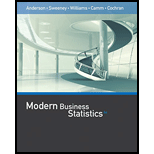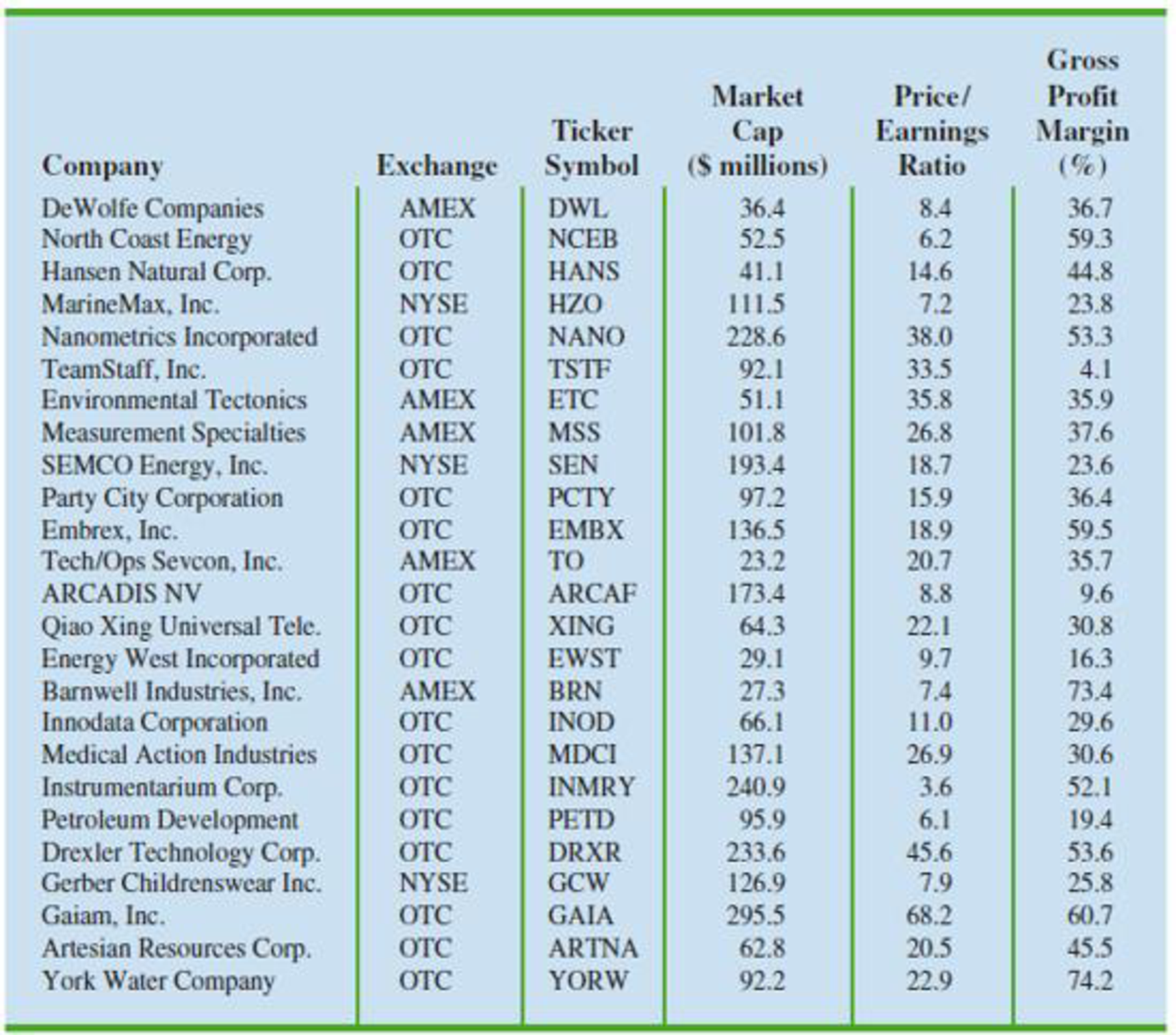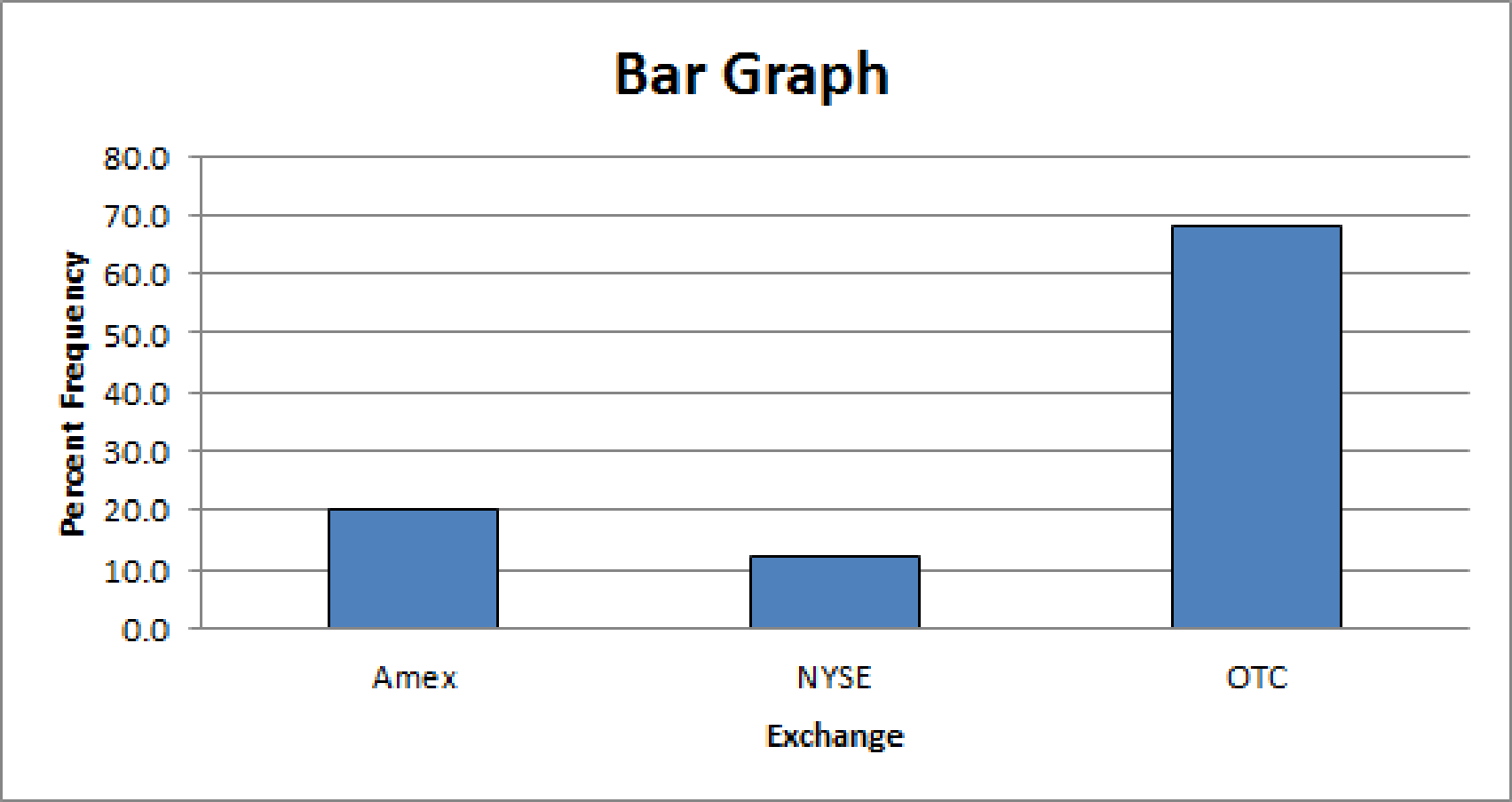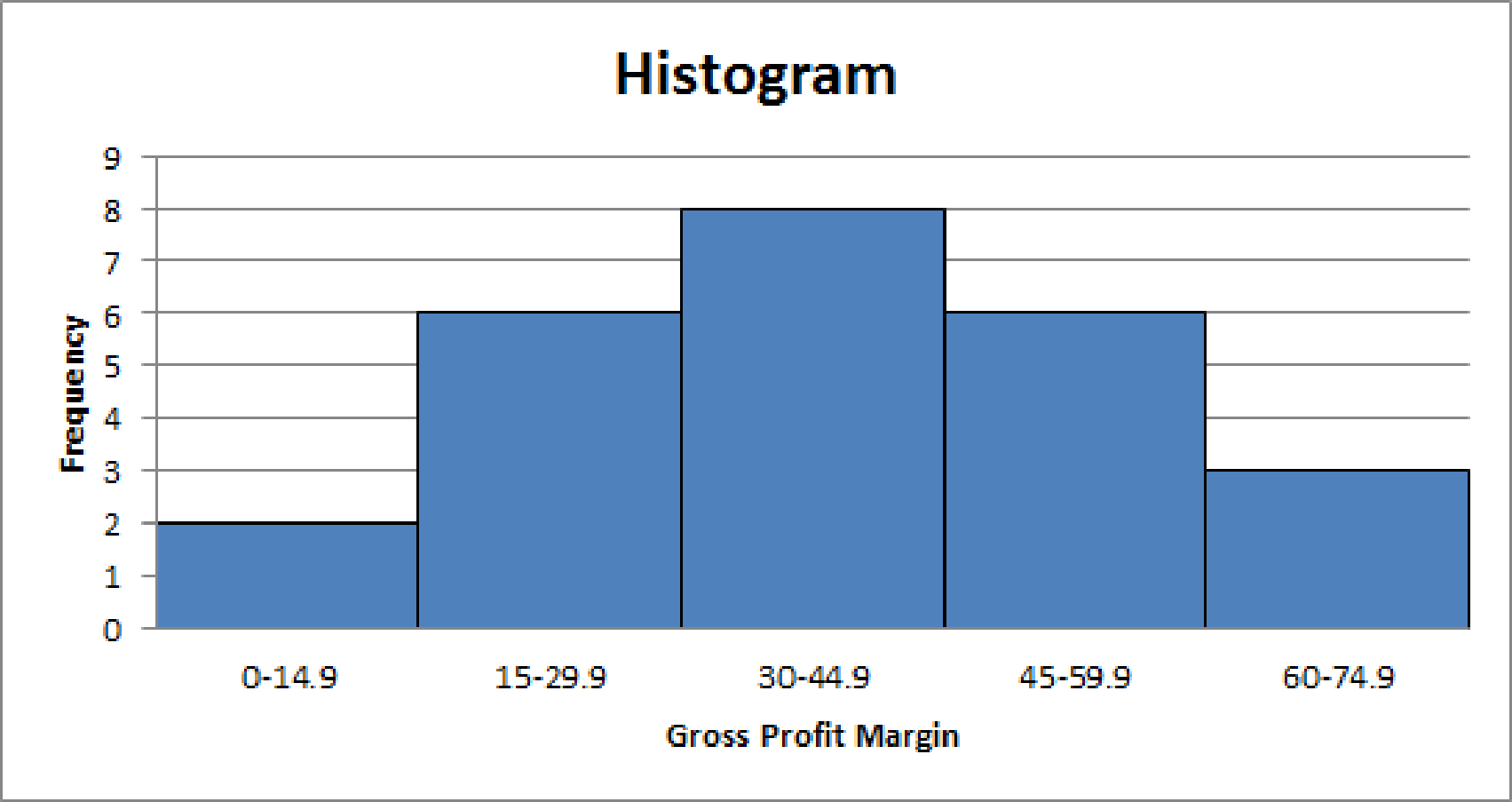
Table 1.8 shows a data set containing information for 25 of the shadow stocks tracked by the American Association of Individual Investors. Shadow stocks are common stocks of smaller companies that are not closely followed by Wall Street analysts. The data set is also on the website that accompanies the text in the DATA file named Shadow02.
TABLE 1.8 DATA SET FOR 25 SHADOW STOCKS

- a. How many variables are in the data set?
- b. Which of the variables are categorical and which are quantitative?
- c. For the Exchange variable, show the frequency and the percent frequency for AMEX, NYSE, and OTC. Construct a bar graph similar to Figure 1.4 for the Exchange variable.
- d. Show the frequency distribution for the Gross Profit Margin using the five intervals: 0–14, 9, 15–29.9, 30–44.9, 45–59, 9, and 60–74, 9, Construct a histogram similar to Figure 1.5.
- e. What is the average price/earnings ratio?
a.
Find the number of variables.
Answer to Problem 25SE
There are five variables.
Explanation of Solution
The given information is about the companies, exchanges, ticker symbols, market capitals, price/earnings ratios and the gross profit margins of 25 shadow stocks.
Here, for the 25 shadow stocks, the exchange, ticker symbol, market cap, price/earnings ratio, and gross profit margin are recorded for analysis purposes. Therefore, these five are the variables under study.
Thus, there are five variables.
b.
Identify the categorical and quantitative variables.
Answer to Problem 25SE
Exchange and ticker symbol are categorical variables.
Market cap, price/earnings ratio, and gross profit margin are quantitative variables.
Explanation of Solution
The definitions of categorical and quantitative variables are given below.
Categorical variable:
Labels or names that are used to recognize the attributes of each element in a study are called categorical data. In other words, such data can be grouped under specific categories. Hence, a variable with categorical data is called a categorical variable.
Quantitative variable:
The data that take up numerical values, which can be measured or counted are called quantitative data. A variable with quantitative data is called quantitative variable.
The variable, exchange represents the names of the stocks, which categorize the stocks. The ticker symbols also classify the stocks. Thus, the variables exchange and ticker symbol are categorical variables.
The market cap values, price/earnings ratios and gross profit margin are represented in numerical values that are measured. Thus, the variables market cap, price/earnings ratio, and gross profit margin are quantitative variables.
c.
Find the frequencies and the percent frequencies for AMEX, NYSE, and OTC.
Construct a bar graph for the data.
Answer to Problem 25SE
The frequencies and the percent frequencies for AMEX, NYSE, and OTC are tabulated below:
| Exchange | Frequency | Percent Frequency |
| AMEX | 5 | 20% |
| NYSE | 3 | 12% |
| OTC | 17 | 68% |
The bar graph for the data is as follows:

Explanation of Solution
Calculation:
From the data set for the 25 shadow stocks, the frequency and the percentage of the frequency for AMEX, NYSE, and OTC are obtained as follows:
| Exchange | Tally | Frequency | Percent Frequency |
| AMEX | 5 | ||
| NYSE | 3 | ||
| OTC | 17 | ||
| Total | 25 | 100 |
Software Procedure:
Step-by-step procedure to draw the bar graph using EXCEL software:
- Open an EXCEL sheet.
- Enter the exchanges and the corresponding percent frequencies in columns A and B respectively, under the headings of Exchange in cell A1 and Percent Frequency in cell B1.
- Select the entered data along with the headings.
- Choose Insert > Column > 2-D Column > Clustered Column.
- Choose Layout > Chart Title > Above Chart and enter Bar Graph.
- Choose Layout > Axis Title > Primary Horizontal Axis Title > Title Below Axis and enter Exchange.
- Choose Layout > Axis Title > Primary Vertical Axis Title > Rotated Title and enter Percent Frequency.
Hence, the bar graph for the data is obtained using EXCEL software.
d.
Construct the frequency distribution for the gross profit margin.
Construct a histogram using the given intervals.
Answer to Problem 25SE
The frequency distribution for the gross profit margin is given below:
| Intervals | Frequency |
| 0–14.9 | 2 |
| 15–29.9 | 6 |
| 30–44.9 | 8 |
| 45–59.9 | 6 |
| 60–74.9 | 3 |
The histogram using the given intervals is as follows:

Explanation of Solution
Calculation:
The given intervals are 0–14.9, 15–29.9, 30–44.9, 45–59.9, and 60–74.9.
The frequency for each class is obtained, and the distribution for the gross profit margin is tabulated below:
| Intervals | Tally | Frequency |
| 0–14.9 | 2 | |
| 15–29.9 | 6 | |
| 30–44.9 | 8 | |
| 45–59.9 | 6 | |
| 60–74.9 | 3 |
Software Procedure:
Step-by-step procedure to draw the histogram using EXCEL software:
- Open an EXCEL sheet.
- Enter the intervals for the gross profit margins and the corresponding frequencies in columns A and B respectively, under the headings of Gross Profit Margin in cell A1 and Frequency in cell B1.
- Select the entered data along with the headings.
- Choose Insert > Column > 2-D Column > Clustered Column.
- Choose Layout > Chart Title > Above Chart and enter Histogram.
- Choose Layout > Axis Title > Primary Horizontal Axis Title > Title Below Axis and enter Gross Profit Margin.
- Choose Layout > Axis Title > Primary Vertical Axis Title > Rotated Title and enter Frequency.
- Double click on a bar and in Series Options, set the Gap Width to the minimum of No Gap or 0%.
Hence, the histogram for the gross profit margin is obtained using EXCEL software.
e.
Find the average price/earnings ratio.
Answer to Problem 25SE
The average price/earnings ratio is $ 20.2 million.
Explanation of Solution
Calculation:
The average price/earnings ratio can be obtained using software.
Software Procedure:
Step-by-step procedure to obtain the average using EXCEL software:
- Open an EXCEL sheet.
- Enter the data on price/earnings ratio in cells E3 to E27 in column E, under the heading of average Price/Earnings Ratio in cell E2.
- In cell C1, enter the formula =AVERAGE(E3:E27).
- Press Enter.
Output using the EXCEL software is given below:

Hence, the average price/earnings ratio is $ 20.2 million.
Want to see more full solutions like this?
Chapter 1 Solutions
Modern Business Statistics with Microsoft Office Excel (with XLSTAT Education Edition Printed Access Card) (MindTap Course List)
- A special interest group reports a tiny margin of error (plus or minus 0.04 percent) for its online survey based on 50,000 responses. Is the margin of error legitimate? (Assume that the group’s math is correct.)arrow_forwardSuppose that 73 percent of a sample of 1,000 U.S. college students drive a used car as opposed to a new car or no car at all. Find an 80 percent confidence interval for the percentage of all U.S. college students who drive a used car.What sample size would cut this margin of error in half?arrow_forwardYou want to compare the average number of tines on the antlers of male deer in two nearby metro parks. A sample of 30 deer from the first park shows an average of 5 tines with a population standard deviation of 3. A sample of 35 deer from the second park shows an average of 6 tines with a population standard deviation of 3.2. Find a 95 percent confidence interval for the difference in average number of tines for all male deer in the two metro parks (second park minus first park).Do the parks’ deer populations differ in average size of deer antlers?arrow_forward
- Suppose that you want to increase the confidence level of a particular confidence interval from 80 percent to 95 percent without changing the width of the confidence interval. Can you do it?arrow_forwardA random sample of 1,117 U.S. college students finds that 729 go home at least once each term. Find a 98 percent confidence interval for the proportion of all U.S. college students who go home at least once each term.arrow_forwardSuppose that you make two confidence intervals with the same data set — one with a 95 percent confidence level and the other with a 99.7 percent confidence level. Which interval is wider?Is a wide confidence interval a good thing?arrow_forward
- Is it true that a 95 percent confidence interval means you’re 95 percent confident that the sample statistic is in the interval?arrow_forwardTines can range from 2 to upwards of 50 or more on a male deer. You want to estimate the average number of tines on the antlers of male deer in a nearby metro park. A sample of 30 deer has an average of 5 tines, with a population standard deviation of 3. Find a 95 percent confidence interval for the average number of tines for all male deer in this metro park.Find a 98 percent confidence interval for the average number of tines for all male deer in this metro park.arrow_forwardBased on a sample of 100 participants, the average weight loss the first month under a new (competing) weight-loss plan is 11.4 pounds with a population standard deviation of 5.1 pounds. The average weight loss for the first month for 100 people on the old (standard) weight-loss plan is 12.8 pounds, with population standard deviation of 4.8 pounds. Find a 90 percent confidence interval for the difference in weight loss for the two plans( old minus new) Whats the margin of error for your calculated confidence interval?arrow_forward
- A 95 percent confidence interval for the average miles per gallon for all cars of a certain type is 32.1, plus or minus 1.8. The interval is based on a sample of 40 randomly selected cars. What units represent the margin of error?Suppose that you want to decrease the margin of error, but you want to keep 95 percent confidence. What should you do?arrow_forward3. (i) Below is the R code for performing a X2 test on a 2×3 matrix of categorical variables called TestMatrix: chisq.test(Test Matrix) (a) Assuming we have a significant result for this procedure, provide the R code (including any required packages) for an appropriate post hoc test. (b) If we were to apply this technique to a 2 × 2 case, how would we adapt the code in order to perform the correct test? (ii) What procedure can we use if we want to test for association when we have ordinal variables? What code do we use in R to do this? What package does this command belong to? (iii) The following code contains the initial steps for a scenario where we are looking to investigate the relationship between age and whether someone owns a car by using frequencies. There are two issues with the code - please state these. Row3<-c(75,15) Row4<-c(50,-10) MortgageMatrix<-matrix(c(Row1, Row4), byrow=T, nrow=2, MortgageMatrix dimnames=list(c("Yes", "No"), c("40 or older","<40")))…arrow_forwardDescribe the situation in which Fisher’s exact test would be used?(ii) When do we use Yates’ continuity correction (with respect to contingencytables)?[2 Marks] 2. Investigate, checking the relevant assumptions, whether there is an associationbetween age group and home ownership based on the sample dataset for atown below:Home Owner: Yes NoUnder 40 39 12140 and over 181 59Calculate and evaluate the effect size.arrow_forward
 Glencoe Algebra 1, Student Edition, 9780079039897...AlgebraISBN:9780079039897Author:CarterPublisher:McGraw Hill
Glencoe Algebra 1, Student Edition, 9780079039897...AlgebraISBN:9780079039897Author:CarterPublisher:McGraw Hill Holt Mcdougal Larson Pre-algebra: Student Edition...AlgebraISBN:9780547587776Author:HOLT MCDOUGALPublisher:HOLT MCDOUGAL
Holt Mcdougal Larson Pre-algebra: Student Edition...AlgebraISBN:9780547587776Author:HOLT MCDOUGALPublisher:HOLT MCDOUGAL Big Ideas Math A Bridge To Success Algebra 1: Stu...AlgebraISBN:9781680331141Author:HOUGHTON MIFFLIN HARCOURTPublisher:Houghton Mifflin Harcourt
Big Ideas Math A Bridge To Success Algebra 1: Stu...AlgebraISBN:9781680331141Author:HOUGHTON MIFFLIN HARCOURTPublisher:Houghton Mifflin Harcourt Functions and Change: A Modeling Approach to Coll...AlgebraISBN:9781337111348Author:Bruce Crauder, Benny Evans, Alan NoellPublisher:Cengage Learning
Functions and Change: A Modeling Approach to Coll...AlgebraISBN:9781337111348Author:Bruce Crauder, Benny Evans, Alan NoellPublisher:Cengage Learning



